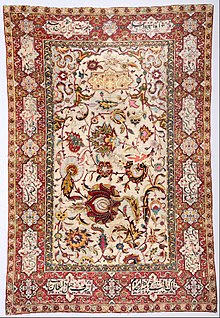
Back سجادة صلاة Arabic Namazlıq xalçaları Azerbaijani Намаҙлыҡ Bashkir Sejadah BEW Pasahapan BJN জায়নামাজ Bengali/Bangla بەرماڵ CKB Bedetæppe Danish Jiliŋgbaŋ DAG Gebetsteppich German

A prayer rug or prayer mat is a piece of fabric, sometimes a pile carpet, used by Muslims, some Christians, especially in Orthodox Christianity and some followers of the Baháʼí Faith during prayer.
In Islam, a prayer mat is placed between the ground and the worshipper for cleanliness during the various positions of Islamic prayer. These involve prostration and sitting on the ground. A Muslim must perform wudu (ablution) before prayer, and must pray in a clean place.
Prayer rugs are also used by some Oriental Orthodox Christians for Christian prayer involving prostrations in the name of the Trinity, as well as during the recitation of the Alleluia and Kyrie eleison.[2] Its purpose is to maintain a cleanly space to pray to God and shoes must be removed when using the prayer rug.[3] Among Russian Orthodox Christians, particularly Old Ritualists, a special prayer rug known as the Podruchnik is used to keep one's face and hands clean during prostrations, as these parts of the body are used to make the sign of the cross.[4]
Many new prayer mats are manufactured by weavers in a factory. The design of a prayer mat is based on the village it came from and its weaver. These rugs are usually decorated with many beautiful geometric patterns and shapes. They are sometimes even decorated with images. These images are usually important Islamic landmarks, such as the Kaaba, but they are never animate objects.[5] This is because the drawing of animate objects on Islamic prayer mats is forbidden.
For Muslims, when praying, a niche, representing the mihrab of a mosque, at the top of the mat must be pointed to the Islamic center for prayer, Mecca. All Muslims are required to know the qibla or direction towards Mecca from their home or where they are while traveling. Oriental Orthodox Christians position their prayer rugs so that they face east, the direction of prayer towards which they offer prayer.
- ^ "Carpet". Discover Islamic Art.
- ^ Cite error: The named reference
Kosloski2017was invoked but never defined (see the help page). - ^ Bishop Brian J Kennedy, OSB. "Importance of the Prayer Rug". St. Finian Orthodox Abbey. Archived from the original on 25 July 2020. Retrieved 31 March 2023.
- ^ Basenkov, Vladimir (10 June 2017). "Vladimir Basenkov. Getting To Know the Old Believers: How We Pray". Orthodox Christianity. Retrieved 25 July 2020.
- ^ Cite error: The named reference
Gantzhorn1998was invoked but never defined (see the help page).